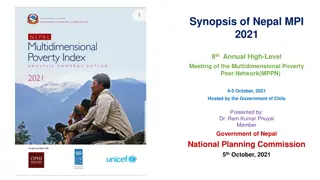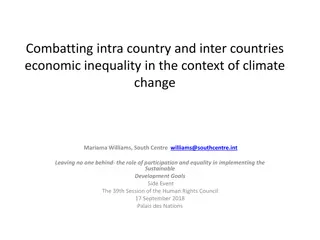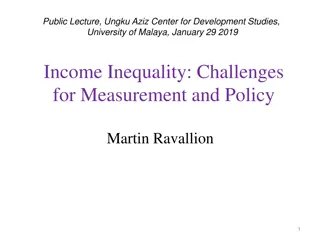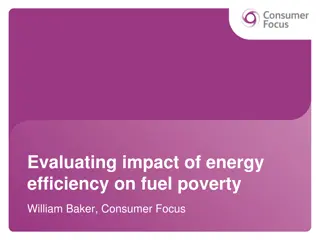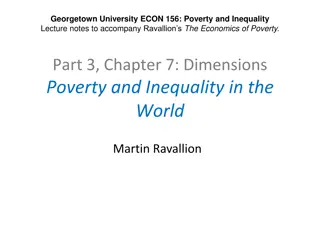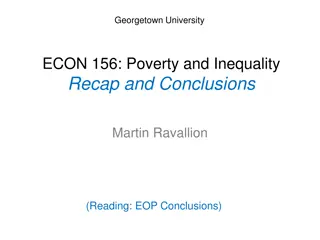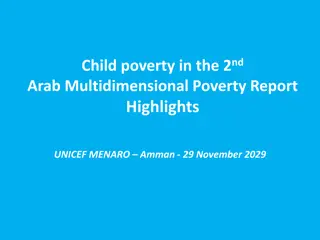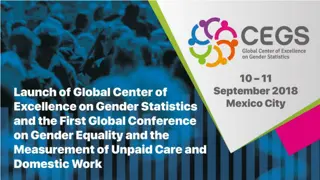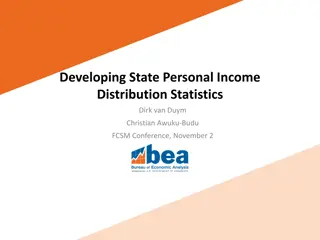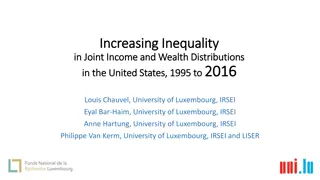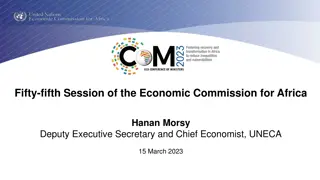Understanding Non-Income Dimensions of Poverty and Inequality
Exploring the various non-income dimensions of poverty, this lecture discusses child development, demographics, schooling, gender disparities, nutrition, and violence as critical factors influencing poverty levels globally. Highlighting the impact of early childhood nutrition, cognitive abilities, and verbal interactions, the lecture sheds light on the lasting effects of poverty on different aspects of human development.
Download Presentation

Please find below an Image/Link to download the presentation.
The content on the website is provided AS IS for your information and personal use only. It may not be sold, licensed, or shared on other websites without obtaining consent from the author. Download presentation by click this link. If you encounter any issues during the download, it is possible that the publisher has removed the file from their server.
E N D
Presentation Transcript
Georgetown University course ECON 156: Poverty Lecture notes to accompany Ravallion sThe Economics of Poverty. Part 3, Chapter 7: Dimensions Poverty and Inequality in the World: Non-income dimensions Martin Ravallion
Outline Part 3, Chapter 7 1. Poverty and inequality in America 2. Global inequality 3. Global poverty 3.1 Absolute poverty globally 3.2 Taking social effects on welfare seriously 3.3 Measures of absolute poverty 3.4 Measures of relative poverty 3.5 Overall measures of global poverty 4. Urban and rural dimensions of poverty 5. Non-income dimensions of poverty 5.1 Child development and poverty 5.2 Demographics of poverty 5.3 Schooling and poverty 5.4 Gender dimensions of poverty 5.5 Nutrition and poverty 5.6 Violence and poverty 2
5. Non-income dimensions of poverty (EOP, Section 7.5) Child development and poverty Demographics of poverty Schooling and poverty Gender dimensions of poverty Nutrition and poverty Violence and poverty 3
5.1 Poverty and childhood development Poor nutrition in early years of life is recognized as one of the factors creating socioeconomic differentials in ability that are found to persist into earning years. For example, low birth weight is a strong predictor of adult labor market earnings (though other factors can compensate). Undernutrition pre-natal and in early childhood is more common in poor families, but not only in poor families. Cognitive development: IQ at birth varies little by socio- economic status; gaps appear from around age 2. 4
Not just kids nutrition: talking to them matters! Lack of verbal interaction in early childhood => lasting gaps in language skills. Under the pressure of time, poor families (both parents working) may have little choice but to minimize personal child care including verbal interactions. Evidence? The Peabody Picture Vocabulary Test is widely used for testing, whereby children are shown pictures and asked to identify which image corresponds to the word announced by the test giver. 5
Poverty and non-cognitive abilities Studies across a number of countries have revealed sizable differences in Peabody test results in early childhood between rich and poor families. Across five Latin American countries, the differences in Peabody test scores between children 3-6 years of age in the poorest 10% and the richest 10% of families according to a wealth index range from 1.0-1.6 standard deviations, and are statistically significant. Three-quarters or more of the variance in test scores is accountable to wealth differences. 6
Lasting effects into adulthood There are likely to be important feedback effects whereby poverty in childhood has negative effects on productivity and (hence) incomes. The availability of long-period panel data has revealed that the ability differences in childhood persisted into the earning years in the U.S. Thus poverty can self-perpetuate. 7
5.2 Demographics: morality and fertility 8
Child mortality = share of children (born alive) who die before they are five years old. Large decline in mortality rates since 1800. Yet large differences remain across and within countries. How do mortality vary socio-economic status? Source and further description in the Our World of Data site. 9
Socioeconomic differences in mortality Data problems While estimates are readily available for overall death rates, that is not the case for death rates conditional on income or other socio-economic variables. Large sample sizes are needed for reliable survey-based estimates, given low frequency. Demographic and Health Surveys (DHS) have adequate sample sizes for some vital statistics but do not collect data on consumption, income or wealth. Proxy indicators constructed using a wealth index: a composite index of various assets (housing, durables car, bike, electric apps., water and sanitation). 10
Using the DHS wealth index to study mortality differentials On average the poorest quintile in developing countries (in terms of the DHS wealth index) has an infant mortality rate that is 17% higher than average. This rises to 35% if one focuses on low and middle income countries only. See other evidence reviewed: EOP Chapter 7, Sect.7.5. However, common shocks and shared (ill)health environments can also entail high child mortality in non- poor families, esp., in poor countries. 11
Fertility rates across the globe (Children born per woman) Time series map here. Child mortality rates here. 12
Socioeconomic differences in fertility Poor families, judged by consumption or income per person, tend to have higher birth rates. DHS using wealth index: Averaged over 45 developing economies, the total fertility rate is estimated to be 6.2 for the poorest quintile as compared to 3.3 for the richest quintile, with a population average of 4.7. On other evidence see EOP Chapter 7, Section 7.5. 13
Age profiles 100% 5% 8% > 60 80% Percentage by age group in years 47% 59% 19-60 60% 13% 40% 13-18 13% 20% 34% 20% 0-12 0% Poor Non-Poor These calculations are based on household consumption per person relative to poverty line of $1.25 a day. 14
How should we interpret these socio- economic differentials in fertility? The observation of higher fertility in poor families has led many observers to blame poor people for their poverty on the grounds that they reproduce too much. We saw in Part 1 that this argument was often made by the influential classical economists from around the turn of the 19th century (including Malthus). However, this reasoning is simplistic. 15
How should we interpret? Cont. The desired number of births will be the sum of desired family size and the expected number of infant deaths. Fertility = desired family size + expected mortality Both these variables can be expected to depend (directly or indirectly) on the family s wealth. First, consider desired family size: In poorer countries formal social security systems tend to be weak or absent, such that children are deemed desirable for old-age support. This will be even more important for poor parents, for they will lack the wealth to support themselves. 16
How should we interpret? Cont. Second, children of poor parents are less likely to survive due to poor nutrition and health care. To assure that they attain their desired family size, child deaths have to be replaced. So an implication of higher mortality for poor families is higher fertility. On both counts, poverty and the conditions that create it emerge as a cause of a high birth rate rather than a consequence. 17
Allowing for economies of scale in consumption The more one allows for economies of scale in consumption the less likely one will find that larger households are poorer. Children are also found to be more likely to be poor than adults when using the per capita scale, given that child/adult ratios are larger in poor households. However, this too is a questionable basis for claiming that children are poorer, given the likely sensitivity to the scale used. More convincing evidence: some indications that child stunting is more likely in larger households. Subjective welfare data do not typically suggest that larger households are poorer. Why? 18
5.3 Schooling and poverty Proportion of 15-19 year olds who have completed grade 6 School completion rates across countries from the DHS for the richest and poorest quintiles based on the DHS wealth index. Amongst countries where 50% of those aged 15-19 had completed grade 6, the mean completion rate was 76% for the richest quintile of families but only 24% amongst the poorest. Part 3.3 returns to schooling. 1.0 Overall mean Poorest quintile Richest quintile 0.8 0.76 0.6 0.4 0.24 0.2 0.0 0.5 0.0 0.2 0.4 0.6 0.8 1.0 Proportion of 15-19 year olds who have completed grade 6 Source:Deon Filmer s Education Attainment database at World Bank. 19
Missing women Discrepancy between the actual counts of women with what one would have expected based on rich countries. For example, in the U.S. and U.K. the sex ratio at birth is 1.05 (105 males to 100 females), while in China and India it is 1.12. Amartya Sen drew attention to the sizeable number of missing women, and argued that this was probably due to selective abortion (though this is far less likely amongst the poor) and parental allocations across children favoring boys. Sen s total count of missing women was 100 million, although a subsequent calculation by Coale put the count at 60 million. 21
Missing in Africa too? At what ages? It has been widely believed that the bias against girls is largely confined to Asia (China and India being prominent in the literature) and to the pre-natal period or the first few years of life. This form of gender bias is thought to be far less evident in Sub-Saharan Africa. However, recent research has questioned this prevailing view (Anderson and Ray). Yes, missing female children but also excess deaths amongst adult women in Africa and Asia. 22
Feminization of poverty Four factors in the feminization of poverty: First, poor women typically work longer hours than do men, notably when account is taken of domestic labor (within the household). The pressure of poverty to increase female labor force participation does not typically come with reduced work at home. Second, poor women typically face fewer opportunities for independently escaping poverty. Their domestic commitments and cultural taboos often prevent them from taking up new opportunities as readily as can men. 23
Feminization of poverty cont. Third, in some cultures widows face effective barriers against employment or remarriage, and are treated as second-class citizens within the home, leading to high risks of poverty. "when Bummi's papa passed, the plot of land he owned where they farmed cassava and yam was taken by his relatives in broad daylight, you were his traditional wife, not his legal one, they shouted at {Bummi s mother} as they descended on her hut directly after his funeral" (Bernardine Evaristo, Girl, Woman, Other, p.159) Fourth: poor women are more vulnerable to risk=> 24
Vulnerability to shocks Cross-country: GDP gains have similar effects on the infant mortality rates of boys and girls; but girls are more vulnerable to contractions in GDP. Example 1: Ethiopia: Poorer people are less able to smooth their consumption in the face of income risk. Women in poor households are the most exposed to uninsured risk (Dercon and Krishnan). Example 2: Widows in Mali: loss of husband => shock to current livings standards and passed onto the next generation through worse schooling outcomes of children (van de Walle). => Uninsured risk can also be a mechanism for the inter- generational transmission of poverty. 25
Overview The nutrition problems today are about both undernutrition and obesity. Both are associated with poverty, though the causation is more complex. Undernutrition is usually the more common problem in poor countries, while it is obesity in rich countries. However, in some countries (and even some families) we see both problems side-by-side! Obesity is also a rising concern in middle-income countries. 27
Measurement for children In measuring the nutritional status of children, two widely used measures are weight-for-height ( wasting ) and height-for-age ( stunting ). Wasting is usually indicated by a child being two standard deviations below the median weight given height of a reference population. Stunting is indicated by a child being two standard deviations below the median height for age of the reference population. Reference population is typically healthy well-nourished children in the U.S. in 70s. Normal distribution: Each band is one standard deviation (*) 28
Causes and lasting effects of retarded growth in childhood Wasting tends to be more transient; often reflecting shocks. Stunting is more persistent, longer-term. Stunting in childhood retards education and learning, with lasting consequences for adult earnings. Poverty self-perpetuates. Stunting often stems from both undernutrition (calories, protein, micronutrients) and a poor health environment, with greater exposure to diseases, and reduced nutrient absorption (correlated with poverty). Persistent fecal-oral contamination can lead to undernutrition; this is environmental enteropathy => 29
Environmental enteropathy (EE) EE is caused by constant fecal-oral contamination and resulting in blunting of intestinal villi and intestinal inflammation. Long known to exist, the clinical impact of EE has only recently been understood. Source: UVA School of Medicine EE => purely nutritional interventions can fail. 30
The importance of publicly-provided goods EE points to the limitations of higher private incomes alone; this can increase nutrient intakes but that may not improve nutritional status much due to EE. Access to non-market goods health care, water and sanitation matters as well as income-poverty reduction. 31
Weight Adult nutritional status BMI = 2 Height A widely used index of adult nutritional status from the DHS is the Body-Mass Index (BMI) given by weight in kilograms divided by height in meters squared. The BMI cut-off for identifying underweight adults is usually set at 18.5. The BMI cut-off for being overweight is usually set at 25. For obesity it is set at 30. National Institutes of Health BMI calculator (in lb and ft). BMI makes no distinction between weight as fat and that as muscle. (Sumo wrestlers have mean BMI of 36.) Some evidence that waist-to-height is a better predictor of disease risk. 32
Data/measurement problems Standard measures based on weight, height and age. In socio-economic surveys these are often self-reported (adults) or parentally reported (children). Measurement errors: poor parents are sometimes unsure of key variables, such as children s age (absent birth certificate). Best practice uses mobile scales in the field, though age is still usually reported by parents. Clues from well-known events. World Vision guidebook: 33
Recent evidence from the Young Lives Project Ethiopia, India (although only one state, namely Andhra Pradesh), Peru and Vietnam. Anthropometric measures of stunting and wasting are correlated with measures of poverty, primarily based on a composite index of wealth, with controls for other sources of heterogeneity in the data. Poorer families had consistently and significantly worse anthropometric outcomes for their children. The impact of poverty on stunting tends to be greater the younger the children. 34
Stunting rates for children in Africa by country Child malnutrition in Africa 6 5 4 Frequency Chronic undernutrition among children is a major concern in many countries in Africa. The region s rate of child stunting is now the highest in the world (overtaken South Asia). The count of stunted children in Africa has risen by 12.5 million since 1990. 3 2 Burundi 1 0 10 15 20 25 30 35 40 45 50 55 Wasting rates for children in Africa (by country) 8 7 6 5 Frequency 4 3 2 1 0 2 4 6 8 10 12 14 16 18 35
Child stunting and household poverty across Africa 60 Burundi 50 Stunting rate (%) 40 30 20 10 0 10 20 30 40 50 60 70 80 Headcount index (% living below $1.90 a day, 2011 PPP) Note: Stunting rate = % height-for-age z score two st. dev. below mean 36
Is it poverty or low GDP? Maybe this correlation only reflects the fact that countries with higher GDP tend to have lower poverty rates. Is GDP all we need to worry about? No! Controlling for the poverty rate there is only a weak correlation between stunting and GDP per capita. + + log( + log( ) log( ) ) S = H GDP i i i t ( ) + ( ) 0 Log stunting rate Log GDP p.c. Log poverty rare For Africa (n=30) one finds that and that . This is an example of omitted variable bias in the regression of stunting on GDP, = = . 0 42 ( . . . 0 12 ) s e = . 0 = 09 ( . . . 0 06 ) s e 37
GDP matters to child stunting among African countries, but mainly via lower poverty This link is weaker than the other two GDP Stunting (negative) (positive) Poverty 38
Can we rely on household poverty data alone for targeting? Yes, an economic gradient, i.e., children in poor families are more likely to be undernourished (stunted and/or wasted). However, many undernourished children are found in households that are not normally deemed to be poor. Africa: Roughly three-quarters of underweight women and undernourished children are not found in poorest 20% of households, and half are not found in the poorest 40% (Brown et al.) Why? Intra-household inequality + common health environment (shared exposure to disease impeding nutrient intake and absorption through EE). 39
Child mortality in America Source: Chen, Oster and Williams 41
Child mortality and poverty in America Pooling micro data across countries, and running regressions for child mortality, with controls (incl. birthweight). US has about the same infant mortality rate in the neonatal (<1 month) period. The divergence with Western Europe comes post- neonatal (1-12 months). Adding controls to the regression for socioeconomic status: The post-neonatal mortality disadvantage is driven by poor birth outcomes among lower socioeconomic status individuals. (Chen, Oster and Williams). 42
Obesity and poverty (EOP: pp. 359-363) In poor countries, poor people tend to be underweight. Those who are overweight are more likely to come form better off strata. In rich countries, we see the opposite: there tends to be a negative economic gradient in weight poorer people are more likely to be overweight. 43
Obesity and poverty in the U.S. Rising caloric intakes since around 1980 => one third of US adults are classified as obese (BMI>30). Higher incidence in poorer states. Obesity incidence in 2012 (% with BMI>30) Obesity rate Controlling for mean/median 40 Louisiana r=0.75 35 r=0.44 30 New Hampshire 25 District of Columbia 20 15 6 8 10 12 14 16 18 20 22 Poverty rate for 2010-12 from the U.S. Census Bureau 44
Economic factors: Cheaper food Relative prices: technological changes (deep freezers, better preservatives, artificial flavors, vacuum seals and microwaves ) in rich world since the 1970s have reduced the time price of eating. Prior to those changes, almost all meals were prepared at home from the raw ingredients. Also, new technologies have allowed large-scale food manufacturing at central locations exploiting economies of scale => cheaper food. Thus the full price of food (including time in preparation and cleaning up) fell, which stimulated higher demand. 45
Economic factors cont.: cheap but unhealthy food? Relative price of healthy foods may well rise with economic development, or not fall as quickly Fresh un-processed produce is not as easily traded internationally and so its price is more dependent on local prices of non-traded inputs, including land and labor. Hypothesis: a reasonable composite bundle of healthy foods may well be more expensive in richer countries given that real wages and land rents are higher. 46
Overweight teens and wealth in England Alongside (causes and effects): Higher cost of eating well, incl. time in food prep. Rising concentration of fast- food outlets in poor areas. More junk-food ads (fatty and sugary foods). Mental capacity and stress facing poor parents focused on paying the rent. Source: The Economist 11/1/18 47
Why is obesity associated with poverty? The need for both adults to work in the labor market will make the poor and middle-income families more responsive to the lower time price of processed foods. Poor people may be expected to be especially sensitive to price differences between healthy and unhealthy diets, and so will consume a higher share of these unhealthy foods when they have easy access. All this depends in part at least on food tastes, which are influenced by knowledge. => Public information campaigns in rich countries. 48
Is obesity a policy concern? One view: To the extent that rising obesity reflects changes in relative prices associated with technological changes it comes with welfare gains for well-informed and rational consumers. So one should be cautious about the policy implications. However, legitimate policy concerns remain when information on the health costs of the foods consumed is imperfect or habit-forming unhealthy food diets persist even for well-informed consumers. Information campaigns have tried to teach people about the nutritional contents of mass market processed foods and the health costs of being over-weight. 49
5.6 Violence and poverty (EOP: pp. 374-378) 50





